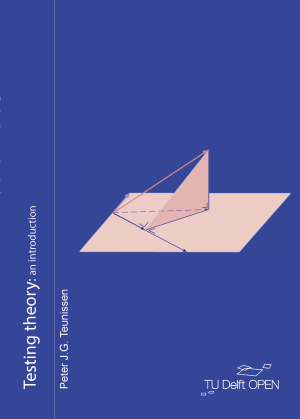Testing theory: an introduction
Synopsis
These lecture notes are a follow up on Adjustment theory. Adjustment theory deals with the optimal combination of redundant measurements together with the estimation of unknown parameters. There are two main reasons for performing redundant measurements. First, the wish to increase the accuracy of the results computed. Second, the requirement to be able to check for mistakes or errors. The present book addresses this second topic. Although one always will try one's best to avoid making mistakes, they can and will occasionally happen. It is therefore of importance to have ways of detecting and identifying such mistakes. Mistakes or errors can come in many different guises. They could be caused by mistakes made by the observer, or by the fact that defective instruments are used, or by wrong assumptions about the functional relations between the observables. When passed unnoticed, these errors will deteriorate the final results.
The goal of this introductory course on testing theory is therefore to convey the necessary knowledge for testing the validity of both the measurements and the mathematical model. Typical questions that will be addressed are: 'How to check the validity of the mathematical model? How to search for certain mistakes or errors? How well can errors be traced? And how do undetected errors affect the final results?' The theory is worked out in detail for the important case of linear(ized) models. Both the parametric form (observation equations) and the implicit form (condition equations) of linear models are treated. As an additional aid in understanding the basic principles involved, a geometric interpretation is given throughout. Attention is also paid to the performance of the testing procedures. The closely related concept of reliability is introduced and diagnostic measures are given to determine the size of the minimal detectable biases. In this introductory text the methodology of testing is emphasized, although various examples are given to illustrate the theory. The methods discussed form the basis for geodetic quality control and they provide the ingredients for the formulation of guidelines for the reliable design of measurement set-ups.
Downloads
References
Almering, J.H.J. et al., revised by H. Bavinck and R.W. Goldbach; Analyse Delft University Press, 6thed. (1996)
Braber, C.A. den, H. van Yperen and M.A. Vlietgever; Matrixrekening Delft University Press, 2nd ed. (1989)
Decnop, G.W., H. van Iperen and R. Martini; Lineaire Algebra Delft University Press, 4th ed. (1986)
Lay, D.C.; Linear algebra and its applications. Reading, Addison-Wesley, 2nd ed. (1997)
Ortega, J.M.; Matrix theory, a second course. New York, Plenum Press, (1987) https://doi.org/10.1007/978-1-4899-0471-3
Strang, G.;Linear algebra and its applications.San Diego, Harcourt Brace Jovanovich Publishers, 3rd ed. (1988)
Teunissen, P.J.G.;Generalized inverses, adjustment, the datum problem and S-transformations. In: Optimization and design of geodetic networks, Ed. E. Grafarend and F. Sansò,Springer Verlag, (1985), pp. 11-54 https://doi.org/10.1007/978-3-642-70659-2_3
Breiman, L.; Probability and stochastic processes: with a view toward applications. Boston, Houghton Mifflin Company, (1969)
Grimmett, G. and D. Welsh; Probability, an introduction. Oxford, Clarendon Press, (1986)
Lopuhaä, H.P.; Lecture notes: Statistiek voor geodeten. Delft University of Technology, Faculty of Information Technology and Systems, (1994)
Miller, R.G.; Simultaneous statistical inference. New York, McGraw-Hill Book Company, (1966)
Papoulis, A.; Probability, random variables and stochastic processes. New York, McGraw-Hill Book Company, (1991)
Peebles, P.Z.;Probability, random variables and random signal principles. New York, McGraw-Hill Book Company, (1987)
Soest, J. van; Elementaire statistiek. Delft University Press, 7th ed. (1997)
Abramowitz, M. and I.A. Stegun; Handbook of mathematical functions, graphs and mathematical tables. New York, Dover, 7th ed. (1970)
Arnold, S.F.;The theory of linear models and multivariate analysis. New York, John Wiley & Sons, (1981)
Baarda, W.; Statistical concepts in geodesy. Netherlands Geodetic Commisssion, Publ. on Geodesy, New Series 2(4), (1967) https://doi.org/10.54419/bjdeu2
Baarda, W.;A testing procedure for use in geodetic networks. Netherlands Geodetic Commission, Publ. on Geodesy, New Series 2(5), (1968) https://doi.org/10.54419/t8w4sg
Ghosh, B.K.;Some monotonicity theorems for c2, F and t-distributions with applications. J.R. Statist. Soc. 35, (1973), pp. 480-492 https://doi.org/10.1111/j.2517-6161.1973.tb00976.x
Graybill, F.A.;Theory and application of the linear model. North Scituate, Duxbury Press, (1976)
Hays, W.L.; Statistics. New York, Holt, Rinehart and Winston, 4th ed. (1988)
Koch, K.R.; Parameter estimation and hypothesis testing in linear models. Berlin, Springer Verlag, 2nded. (1999) https://doi.org/10.1007/978-3-662-03976-2
Melsa, J. and D. Cohn; Decision and estimation theory. New York, McGraw-Hill Book Company, (1978)
Mikhail, E.; Observations and least-squares. New York, IEP-Dun-Donnelley, (1976)
Mood, A.M. and F.A. Graybill; Introduction to the theory of statistics. New York, McGraw-Hill Book Company, 3rded. (1974)
Neyman, J. and E.S. Pearson; On the problem of the most efficient tests of statistical hypotheses. Philos. Trans. Roy. Soc., London Series A231, (1933), pp. 289-337 https://doi.org/10.1098/rsta.1933.0009
Teunissen, P.J.G.;Adjustment theory, an introduction. Delft University Press, 1st ed. (2000)
Teunissen, P.J.G.; Quality control in geodetic networksIn: Optimization and design of geodetic networks, E. Grafarend and F. Sansò (editors),Springer Verlag, (1985), pp. 526-546 https://doi.org/10.1007/978-3-642-70659-2_18
Teunissen, P.J.G.;Adjusting and testing with the models of the affine and similarity transformation Manuscripta Geodaetica, 11(3), (1986), pp. 214-225 https://doi.org/10.1007/BF03655169




